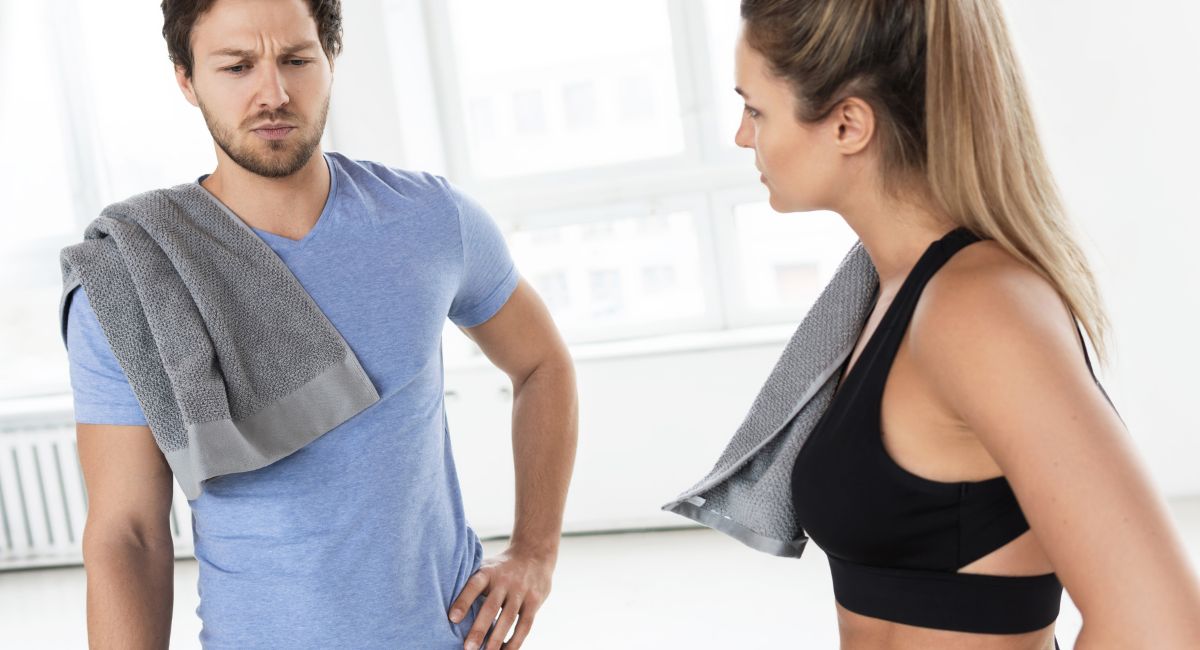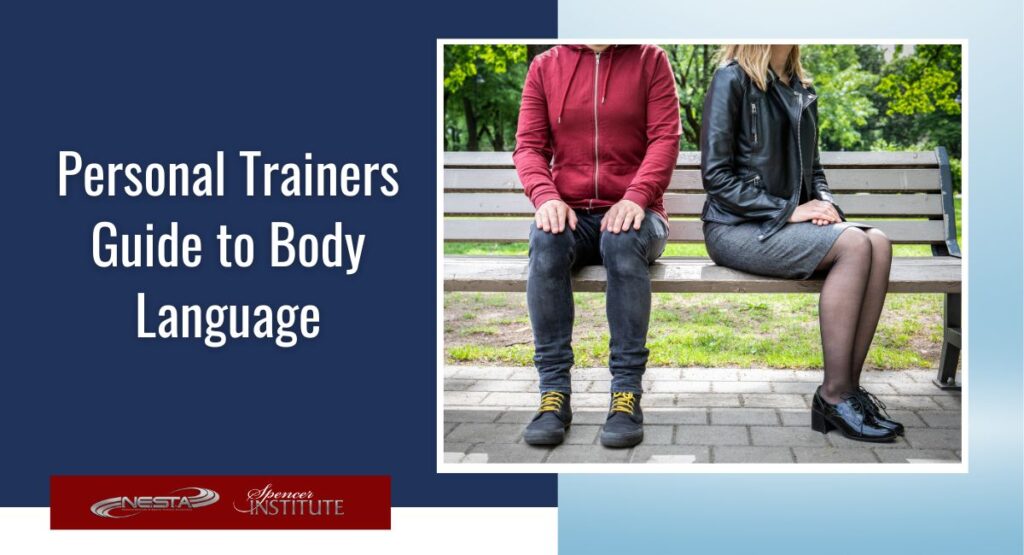
Why it’s Important for Personal Trainers to Understand Client Body Language
Body language is the unspoken way we communicate with others as personal trainers, health coaches, or fitness instructors. It is the physical expression of our thoughts, emotions, and intentions. While spoken language can convey a great deal of information, it is often our body language that truly reveals what we are thinking and feeling. Understanding body language is an important aspect of effective communication, both in personal and professional contexts. In this lesson, we will explore why body language matters, the signs of rapport, body language examples, and how to interpret different types of body language.
It’s important to know that there are often exceptions to interpreting body language. These exceptions can come in the form of cultural differences and the environment in which a person is at the time the body language is being interpreted. How you communicate with someone while working at a health club could be quite different than how you communicate with the same person at a wedding or even the local coffee shop. So, there may be differences in body language because of energy levels, intensity, and the environment itself. It’s important to take all these things into consideration.
Why it Matters
Body language matters because it can communicate more than just the words we use. For example, we may say that we are happy, but if our body language suggests otherwise, our words will not be taken at face value. Conversely, we may say that we are angry, but if our body language is calm and relaxed, our words will not be as effective as we want them to be. These incongruencies can be a sign of deception or confusion. Understanding body language is important for effective communication because it can reveal the true intentions, emotions, and thoughts of the speaker.
Signs of Rapport
When two people have a good rapport, their body language will often reflect this. Some signs of rapport include:
- Mirroring: When two people have a good rapport, they will often mirror each other’s body language. This can include mirroring each other’s posture, gestures, and facial expressions.
- Leaning in: When two people are interested in what the other person is saying, they will often lean in towards each other. This can be a sign of rapport and can indicate that both parties are engaged in the conversation.
- Eye contact: Eye contact is an important aspect of body language and can be a sign of rapport. When two people have a good rapport, they will often maintain eye contact while speaking to each other.
Body Language Examples
- Open Body Language: Open body language is characterized by an open posture, with the arms and legs uncrossed. This type of body language can indicate that the person is open to communication and is not defensive.
- Positive Body Language: Positive body language is characterized by a relaxed posture, with a smile and open facial expression. This type of body language can indicate that the person is happy, confident, and approachable.
- Negative Body Language: Negative body language is characterized by a closed posture, with the arms and legs crossed. This type of body language can indicate that the person is defensive or uncomfortable.
What Percentage of Communication is Non-Verbal?
According to research by Albert Mehrabian, a Professor Emeritus of Psychology at the University of California, Los Angeles, only 7% of communication is conveyed through spoken words. The remaining 93% of communication is conveyed through nonverbal cues, including body language, tone of voice, and facial expressions. While this research has been widely criticized for oversimplifying the complexities of human communication, it does highlight the importance of nonverbal cues in conveying meaning and building rapport.
Exceptions to General Rules about Body Language
While there are general rules about body language, it is important to remember that everyone is different, and their body language may not always conform to these rules. For example, a person who is naturally introverted may have a closed posture, even if they are feeling comfortable and engaged in the conversation. It is important to consider a person’s individual personality and communication style when interpreting their body language.
How Understanding Body Language Can Make You More Likeable
Understanding body language can make you more likable because it can help you to build rapport with others. By mirroring the body language of the person you are speaking to, you can create a sense of connection and trust. By using positive body language, such as a relaxed posture and open facial expression, you can convey that you are approachable and friendly. Additionally, by being aware of negative body language, such as a closed posture or crossed arms, you can try to avoid these behaviors and communicate more effectively.
Open Body Language
Open body language is characterized by a relaxed and open posture, with the arms and legs uncrossed. This type of body language can indicate that the person is open to communication and is not defensive. Some examples of open body language include:
- Uncrossed arms and legs: When a person has their arms and legs uncrossed, it can indicate that they are open and receptive to communication.
- Relaxed posture: A relaxed posture, with shoulders down and chest open, can also indicate that a person is open and approachable.
- Eye contact: Maintaining eye contact can also be a sign of open body language, as it indicates that the person is engaged in the conversation and interested in what the other person is saying.
Positive Body Language
Positive body language is characterized by a relaxed posture, with a smile and open facial expression. This type of body language can indicate that the person is happy, confident, and approachable. Some examples of positive body language include:
- Smiling: A genuine smile can be a powerful form of positive body language, as it can convey warmth, friendliness, and openness.
- Eye contact: Maintaining eye contact while smiling can also be a sign of positive body language, as it indicates that the person is engaged in the conversation and interested in what the other person is saying.
- Relaxed posture: A relaxed posture, with shoulders down and chest open, can also be a sign of positive body language, as it indicates that the person is comfortable and at ease.
Negative Body Language
Negative body language is characterized by a closed posture, with the arms and legs crossed. This type of body language can indicate that the person is defensive or uncomfortable. Some examples of negative body language include:
- Crossed arms and legs: When a person crosses their arms and legs, it can indicate that they are closed off and not receptive to communication.
- Tense posture: A tense posture, with shoulders hunched and body tense, can also be a sign of negative body language, as it indicates that the person is uncomfortable or defensive.
- Lack of eye contact: Avoiding eye contact can also be a sign of negative body language, as it indicates that the person is not engaged in the conversation or is uncomfortable.
Mirroring Body Language
Mirroring body language is a technique that involves mimicking the body language of the person you are speaking to. This can be a powerful way to build rapport and create a sense of connection.
Mirroring can involve:
- Posture: Mirroring the posture of the other person, such as sitting or standing in a similar way, can help to create a sense of connection.
- Gestures: Mirroring the gestures of the other person, such as nodding or using hand gestures, can also help to create a sense of connection and understanding.
- Facial expressions: Mirroring the facial expressions of the other person, such as smiling or frowning, can help to create a sense of empathy and understanding.
Body Language in Photos
Body language is also important in photos, as it can convey a great deal of information about a person’s personality and intentions. Some tips for using body language effectively in photos include:
- Smile naturally: A genuine smile can be a powerful form of positive body language in photos, as it conveys warmth and friendliness.
- Stand or sit tall: Maintaining good posture in photos can convey confidence and professionalism.
- Avoid closed body language: Crossing your arms or legs in photos can convey negative body language and should be avoided.
Rapid Blinking
Rapid blinking can also be a form of body language and can indicate nervousness or discomfort. When a person is feeling anxious or uncomfortable, they may blink rapidly or avoid eye contact. Conversely, when a person is feeling confident and relaxed, they may blink less frequently and maintain steady eye contact.
Sitting Body Language
Sitting body language is also an important aspect of nonverbal communication. Some common sitting body language cues include:
- Crossing legs: When a person crosses their legs while sitting, it can indicate that they are feeling relaxed or comfortable.
- Tapping feet: When a person taps their feet while sitting, it can indicate that they are feeling restless or anxious.
- Leaning forward: When a person leans forward while sitting, it can indicate that they are interested or engaged in the conversation.
Posture and Body Language
Posture is a key element of body language and can convey a great deal of information about a person’s confidence, mood, and intentions. Some common posture cues include:
- Upright posture: When a person stands or sits with an upright posture, it can indicate that they are confident and self-assured.
- Slouching: When a person slouches while standing or sitting, it can indicate that they are feeling lazy or uninterested.
- Tense posture: When a person stands or sits with a tense posture, it can indicate that they are feeling anxious or uncomfortable.
Exceptions to General Rules about Body Language
While body language can be a powerful tool for communication, it is important to remember that there are exceptions to general rules about body language. For example, cultural differences can play a significant role in how body language is interpreted. In some cultures, avoiding eye contact may be a sign of respect, while in others it may be considered rude or untrustworthy.
Additionally, it is important to remember that individual differences can also impact how body language is interpreted. For example, some people may naturally have a closed posture, even if they are feeling open and approachable. It is important to consider a person’s body language in context and to avoid making assumptions based solely on nonverbal cues.
Where Can You Learn More About Body Language and Communication Techniques?
As a personal trainer or coach, understanding body language becomes a vital aspect of your role in transforming lives through fitness and exercise. It is important not to underestimate the profound impact that decoding nonverbal cues can have on your clients’ overall training experience and unlocking their true potential. Every subtle movement and gesture offers valuable insight into their thoughts, emotions, and physical limitations, allowing you to tailor your approach, motivate them effectively, and foster an atmosphere of trust and support. Embracing the language of the body empowers you to inspire, guide, and empower your clients toward their greatest achievements. So, stand tall with open eyes and a receptive heart, ready to elevate your profession and make a lasting impact on those you serve.
To gain high-level skills and understanding of body language, building rapport and communication, we recommend the two following courses:






